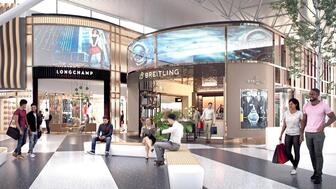The couple pleaded guilty to concealing at least $127 million in cash transactions at its precious metals businesses.
Demographic drop-off
Editor-in-Chief Michelle Graff looks at the reasons why people are getting out of, and not getting into, the jewelry industry.
A few weeks ago, we published a story on the latest quarterly statistics from the Jewelers Board of Trade, which showed that the size of the jewelry industry is continuing to contract, meaning more people are getting out of this business than are getting into it.
The reasons for the industry shrinkage are varied and, though they have been well documented up to this point, after I wrote my most recent JBT story, I began reaching out to retailers and others in the industry to get their perspective. What do they think is the No. 1 factor, or factors, contributing to jewelers closing?
As it turned out, very few could narrow it down to just one thing, but one answer that came up in nearly every reply was this: simple demographics.
The baby boomers, which are the second-largest generation in the U.S., second only to their millennial children, have been running the country’s jewelry stores—and essentially its jewelry industry—for years, but guess what’s happening to them? The same thing that happens to everyone: they are getting old and they want to retire.
I can’t say I blame them.
Retail has changed completely in recent years and in order to keep up in this digital age, jewelers have to figure out new ways of reaching customers and stock different kinds of product—some of which might not be the fine jewelry they are used to—all while fending off online competition and keeping up with the expectations of an increasingly demanding, but not necessarily spendthrift, consumer.
If you were in your mid-50s or 60s and staring down the last five or 10 years of a long career, would you be willing to put in the time and energy to completely change your business if you had the means, or enough of the means, to retire? I wouldn’t.
Some might say the problem is that jewelers are unable to adapt to retailing in the digital age, but I don’t think that’s always the case. I think in some cases it’s more a matter of willingness. Why change
As Dennis Petimezas, owner of Watchmakers Diamonds and Jewelry in Johnstown, Pa., put it, “If you’re 75 to 80 percent of where you need to be to successfully retire, why take the risk? ... Can a mature independent afford to make a mistake at this point and have to work even longer to then try and correct it?”
I think it’s more logical to just take the money you can get out of your business now and retire. Or, if you still need the money and/or just aren’t ready to spend all day on the golf course, do something still jewelry-oriented but perhaps a little (or a lot) less stressful than being a small business owner.
Another factor contributing to the shrinking industry is the decreasing number of young people stepping into the family business.
There are some who say the younger generation is not willing to put in the time it takes to run a small retail store, but I don’t agree with that blanket statement any more that I agree with the assertion that older jewelers are retiring simply because they can’t figure out Facebook.
The majority of companies today are running lean, with one employee shouldering a workload that once was handled by two or even three people. Staff are working long hours no matter what the profession, made longer by the fact that people are on email nearly 24 hours a day.
I don’t think it’s a matter of young people not being willing to work; I think, in many cases, it’s just a matter of them picking different career paths, working for companies that are much younger and, by extension, seem hipper and cooler.
Jewelry isn’t the only industry with this problem.
Over the summer, Fortune magazine did a video interview with GE CEO Jeff Immelt.
Immelt told the interviewer that luring young talent away from Facebook, Google and startups and to GE is one of the issues that keeps him up at night, and this concern is evident in GE’s current advertising campaign featuring Owen, a new, young programmer/developer at GE.
Have you seen these commercials? There are a couple different versions (one of which you can view below) but the message in each is clear: Young people, come work at GE. The work you’ll be doing here will transform the way the world works.
Jewelry does not have its own Owen, but that does not mean the industry’s organizations are ignorant of the need to attract young talent.
The Diamond Council of America, MJSA, the Independent Jewelers Organization, the American Gem Society, the International Colored Gemstone Association and U.S. Antique Shows, which just crowned its first “Antique Young Gun” this past weekend, all are working to pique the next generation’s interest in jewelry. Our associate editor, Brecken, profiled their efforts in our last digital magazine.
It’s not a BBDO-created national advertising campaign on the same scale as GE’s Owen. But, it is a step in the right direction, and it addresses one of the problems impacting the incredible shrinking jewelry industry.
The Latest

Consumers shared concerns about prices, inflation, tariffs, trade, and politics in the survey’s write-in response section.

In February 2026, the auction house will move its headquarters to the former Steinway Hall, a neoclassical landmark on Billionaires’ Row.

How Jewelers of America’s 20 Under 40 are leading to ensure a brighter future for the jewelry industry.

The new show will take place Jan. 23-25, 2026.


The former BHP Billiton leader and Gemfields chairman is remembered for his influential leadership throughout his 50-year mining career.

The LVMH-owned brand has partnered with the costume design union to revamp its award for 2026.

Roseco’s 704-page catalog showcases new lab-grown diamonds, findings, tools & more—available in print or interactive digital editions.

The luxury titan inked a deal to acquire an initial minority stake in the jewelry manufacturer with a pathway to full ownership by 2032.

The company’s curation of unsigned vintage and estate jewelry debuted at the Bloomingdale’s in Costa Mesa, California.

In the recent multi-shipment seizure, CBP also found counterfeit Audemars Piguet, Moncler, and Chrome Hearts items.

Jewelers of America execs and National Jeweler editors discuss tariffs, the sky-high gold price, and the engagement that broke the internet.

The luxury goods company said founder Ippolita Rostagno will remain at the brand’s helm.

Laura Burdese, who joined the Italian luxury brand in 2022, will take on the role in July.

Need a gift for the cat lover who has everything? Look no further than our latest Piece of the Week.

It purchased the “Grosse Pièce,” an ultra-complicated Audemars Piguet pocket watch from the ‘20s, for a record-breaking price at Sotheby’s.

The lab-grown diamond grower now offers custom engagement and fashion jewelry through its Kira Custom Lab Jewelry service.

Chandler got his start at Michelson Jewelers and has served as DCA president and CEO since 2001. He will retire at the end of the month.

The boutique is slated to open this week inside Terminal 8, offering pre-owned Rolex watches and more to international travelers.

Sponsored by Digital Monitoring Products

The special-edition egg pendant ingested in a New Zealand jewelry store was recovered after a six-day wait.

Associate Editor Natalie Francisco plays favorites with Piece of the Week, selecting a standout piece of jewelry from each month of 2025.

The “Love and Desire” campaign is inspired by the magic that follows when one’s heart leads the way, said the brand.

Two awardees will receive free tuition for an educational course at the Swiss lab, with flights and lodging included.

Berta de Pablos-Barbier will replace Alexander Lacik at the start of January, two months earlier than expected.

Sotheby’s held its first two jewelry sales at the Breuer building last week, and they totaled nearly $44 million.

Winners will receive free registration and lodging for its fourth annual event in Detroit.


























